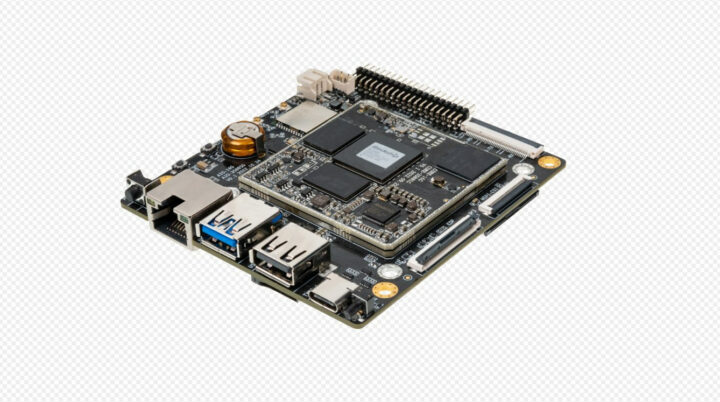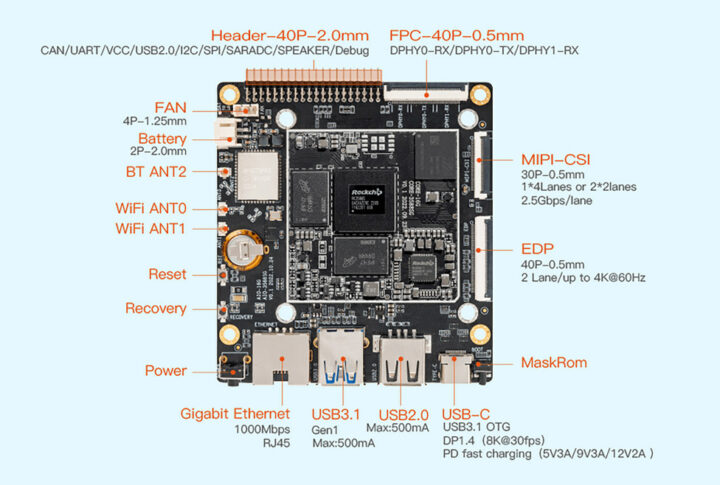Firefly AIO-3588SG is a compact, low-profile SBC with Gigabit Ethernet, WiFi 6, and an 8K capable USB-C port with DisplayPort that is based on the company’s Core-3588SG module powered by a Rockchip RK3588S octa-core Cortex-A76/A55 processor with up to 32GB RAM and 256GB eMMC flash.
The board is designed to be as thin as possible and includes a low-profile RJ45 Ethernet jack which should make it suitable for projects and products that require high performance in a thin form factor such as robotics, digital signage, virtual reality headsets, etc…
Firefly AIO-3588SG specifications:
- System-on-module – Firefly Core-3588SG with
- SoC – Rockchip RK3588S octa-core processor with 4x Cortex-A76 cores @ up to 2.4 GHz, 4x Arm Cortex-A55 cores, Arm Mali-G610 MP4 GPU, 6 TOPS NPU, 8Kp60 video decoder, 8Kp30 video encoder
- System Memory – 4GB, 8GB, or 16GB (32GB optional) 64-bit LPDDR4, LPDDR4x, or LPDDR5
- Storage – 16GB, 32GB, 64GB, 128GB, or 256GB eMMC flash
- PMIC
- Dimensions – 50×50 mm
- Video Output
- DisplayPort 1.4 (USB-C) up to 8Kp60
- MIPI-DSI connector up to 4Kp60
- 2-lane eDP 1.3 connector up to 4Kp60
- Up to three independent displays
- Video Input – 30-pin 4-lane or 2x 2-lane MIPI-CSI connector
- Audio – 4-pin for speaker (on 40-pin GPIO connector), digital audio via DisplayPort
- Networking
- Low-profile Gigabit Ethernet RJ45 port
- Dual-band WiFi 6 (802.11 a/b/g/n/ac/ax) and Bluetooth 5.0 module (AP6275) with 2x WiFi antennas, 1x Bluetooth antenna
- USB
- 1x USB 3.1 Gen1 port
- 1x USB 2.0 Type-A port
- 1x USB Type-C with DP 1.4, OTG, PD fast charging support
- 1x USB 2.0 interface via the 40-pin GPIO header
- Expansion
- 40-pin GPIO header (2.0mm pitch) with CAN bus, UART, USB 2.0, I2C, SPI, SARADC, speaker, debug, VCC, GND
- 40-pin FPC connector (0.5mm pitch) with DPHY0-RX, DPHY0-TX, DPHY1-RX
- Misc
- 4-pin fan connector
- Reset and Recovery buttons
- Power and MaskRom buttons
- RTC with battery
- Power Supply
- 12V (±5%), 2.5A and up via USB-C port (USB PD power adapter is recommended)
- 2-pin battery connector
- Power Consumption
- “Max.” – 15.6W (12V/1.3A) under load, but I assume without peripherals…
- Normal – 5W (12V/0.42A)
- Min. – 0.18W (12V/15mA)
- Dimensions – 88 x 81 mm
- Weight – Around 71 grams
- Temperature Range – Operating: -20°C to 60°C; storage: -20°C to 70°C
- Humidity – 10%90% (non-condensing)
Firefly will provide Android 12.0, Ubuntu, Debian 11, Buildroot, RTLinux, and Kylin Linux support for the Core-3588SG system-on-module and the AIO-3588SG SBC. It’s one of the thinnest Rockchip RK3588S SBC, albeit not quite as thin as the Khadas Edge2 which lacks Ethernet and a GPIO header, and also occupies a smaller area (82 x 57.5mm), but offers fewer I/Os. Firefly hasn’t shown a cooling solution yet although we can see mounting holes for a heatsink, and the Khadas Edge2 is only 11mm thick with a heatsink.
Firefly does not have availability and pricing information for the AIO-03588SG low-profile 8K SBC and the company only says “this product is still not available yet but you can buy it later in Firefly Store”. Additional information may be found on the product page.

Jean-Luc started CNX Software in 2010 as a part-time endeavor, before quitting his job as a software engineering manager, and starting to write daily news, and reviews full time later in 2011.
Support CNX Software! Donate via cryptocurrencies, become a Patron on Patreon, or purchase goods on Amazon or Aliexpress






